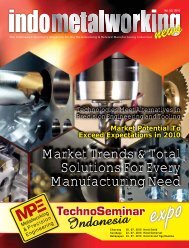High Speed Machining Precision Tooling - Indobiz.biz
High Speed Machining Precision Tooling - Indobiz.biz
High Speed Machining Precision Tooling - Indobiz.biz
Create successful ePaper yourself
Turn your PDF publications into a flip-book with our unique Google optimized e-Paper software.
Figure 13. Positioning error in a semi-closed loop as<br />
a result of local temperature rise in the recirculating<br />
ballscrew<br />
In light of the considerable amount of<br />
heat to be removed it is not an easy<br />
task to maintain a temperature stability<br />
of < 1 K. This is particularly so when the<br />
spindle or its bearings are cooled with<br />
the same system.<br />
In such a case, the required cooling<br />
capacity can easily lie in the kilowatt<br />
range. The temperature constancy<br />
of existing spindle chillers is usually<br />
signifi cantly worse than 1 K. It is<br />
therefore often not possible to use<br />
them to control the temperature of the<br />
ballscrew.<br />
Switching controllers are often used<br />
in the chillers to reduce cost. Since<br />
each switching operation is triggered<br />
by a violation of temperature limits,<br />
the individual switching operation can<br />
be considered to be an expansion of<br />
the cooled ballscrew and therefore an<br />
axis positioning error. Figure 14 shows<br />
the result of a positioning test on a<br />
vertical machining center with liquidcooled<br />
ballscrews in fi xed/fl oating<br />
bearings.<br />
During the test, the axis was moved<br />
slowly at 2.5 m/min between two points<br />
at a distance of 500 mm. The maximum<br />
traverse range was 800 mm. The<br />
position drift of the position farther away<br />
from the fi xed bearing was recorded. The<br />
switching of the chiller is plainly visible.<br />
Its hysteresis was 1 K.<br />
Compared with the noncooled semiclosed<br />
loop design, the absolute position<br />
drift was signifi cantly reduced. However,<br />
the switch operations produce relatively<br />
quick changes in position, which have a<br />
stronger effect during the machining of<br />
workpieces with short machining times<br />
than the slow position drift evident in<br />
the noncooled semi-closed loop design.<br />
SOFTWARE COMPENSATION<br />
Research is underway on compensation<br />
of thermal deformation with the aid<br />
of analytic models, neural networks<br />
and empirical equations. However,<br />
the main focus of these studies is<br />
in the deformation of the machine<br />
tool structure as a result of internal<br />
and external sources of heat. There<br />
is little interest in investigation into<br />
compensation of axis drift.<br />
As a whole, the possibilities of such<br />
software compensation are frequently<br />
overestimated in today’s general<br />
atmosphere of enthusiasm for software<br />
capabilities. Successful compensation<br />
in the laboratory is usually achieved only<br />
after elaborate special adjustments<br />
on the test machine. It is usually not<br />
possible to apply such methods to<br />
machines from series production<br />
Figure 14. X axis of a vertical machining center with liquidcooled<br />
ballscrew in fi xed/fl oating bearings. The diagram<br />
shows the drift of the position farthest away from the fi xed<br />
bearing over 500 mm (800-mm traverse range) at 2.5 m/<br />
min. The axis was also equipped with a linear encoder for<br />
test purposes<br />
without time-consuming adjustment of<br />
the individual machines.<br />
The example of the feed axis shows<br />
the variations on input parameters<br />
to be considered. To compensate<br />
the expansion of the ball screw, its<br />
temperature must be known with<br />
respect to its position, since the<br />
local temperature depends on the<br />
traversing program. Direct temperature<br />
measurement of the rotating<br />
ballscrew, however, is very diffi cult.<br />
Machine tool builders therefore often<br />
attempt to calculate the temperature<br />
distribution.<br />
This is theoretically possible if a heat<br />
analysis can be prepared for individual<br />
sections of the ballscrew. The heat in<br />
such a section is generated by friction in<br />
the ball nut through thermal conductance<br />
along the ballscrew, and through heat<br />
exchange with the environment<br />
The friction of the ball nut depends<br />
almost proportionately on the preload of<br />
the ball nut and, in a complex manner,<br />
from the type, quantity and temperature<br />
of the lubricant. The preload of the<br />
ball nut normally changes by ±10 to<br />
20 percent over its traverse range in<br />
a manner depending on the individual<br />
ballscrew. In the course of the fi rst six<br />
months, the mean preload typically<br />
decreases to 50 percent of its individual<br />
value.<br />
Due to the complex interaction of static<br />
forces at play on the ball screw, certain<br />
jamming effects and an associated<br />
increase in friction are unavoidable.<br />
Even these few of a long list of examples<br />
show that the calculation of the actual<br />
frictional heat presents formidable<br />
problems.<br />
Calculating the heat dissipation is<br />
similarly diffi cult because it depends<br />
strongly on largely unknown ambient<br />
conditions. Even the temperature of<br />
the air surrounding the ballscrew is<br />
indometalworking news Vol. 2 / 2008 35




